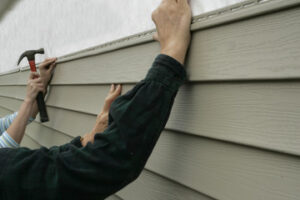New windows can boost your home’s value by making it more appealing to buyers. They can also help to improve its energy efficiency and allow more natural light into the living space.

Unlike new construction windows, replacement windows don’t have nail fins, so they slide into an existing window frame without changing your siding or trim. Read on to learn more about the different options available for this type of installation. Contact Replacement Windows Potomac for professional help.
When it comes to improving your home’s value and curb appeal, there are few projects that offer a better return on investment than replacement windows. Not only will new windows boost your resale value, they can also lower your energy bills and help protect your home from future damage caused by leaky or outdated windows.
However, the cost of replacement windows can vary greatly depending on the type and style you choose. Window materials and features will also affect the price, as will installation costs and additional project expenses like caulking, insulation and window trim. It’s best to shop around and collect quotes from a few highly rated companies before making your decision. And remember that many window companies expect some negotiation, so don’t be afraid to ask for a discount.
One of the biggest factors that will affect your window replacement cost is the size and location of the existing windows. The larger the window, the more expensive it will be to replace.
The best way to ensure that your window replacement project stays within your budget is to work with a professional installer. Not only will they be able to guide you through the process, but they will have access to wholesale pricing that can save you significantly on your overall cost.
It’s also important to have the right measurements before ordering your windows. If the window sizes are too large or too small, they will not fit properly and could cause issues down the line. It’s a good idea to consult with a professional who can provide a precise measurement and recommend the best window sizes for your space.
Aside from the actual cost of your replacement windows, you’ll also need to consider other project expenses. These can include labor, installation materials, taxes and permit fees. It’s a good idea to review your project timeline and schedule with a local window company to make sure that the work will be completed by the time you need it.
When choosing your replacement windows, it’s a good idea to opt for the highest quality that you can afford. This will ensure that your windows perform well and look great for years to come. In addition, higher quality windows are often backed by longer warranties and have better energy efficiency ratings.
Energy Efficiency
Windows are a key source of energy loss in homes. Older single-pane windows, for example, allow cold air to escape in the winter and warm air to leak in during summer, increasing energy consumption and leading to high utility bills. New replacement windows are designed to prevent heat transfer and insulate the home, helping to reduce energy consumption and lower utility bills. The type of frame and glazing are important factors in energy efficiency. Window frames made of wood, vinyl, aluminum or fibreglass can offer different insulation properties. Double-pane windows with low-emissivity coatings can also improve efficiency by reflecting the sun’s heat back into the home in winter and blocking out unwanted UV rays in summer. The energy efficiency of a window is also determined by the amount of insulation between the glass panes and the amount of gases injected between them. Spacers, which are strips of plastic or metal bonded between the glass panes, can also make a difference to energy efficiency by reducing heat transfer and creating an airtight seal.
Whether you’re planning to sell your home or just want to improve its curb appeal, upgrading your windows with more efficient models can help. Buyers are looking for homes that use energy efficiently and have a modern appearance, so making this upgrade can increase your chances of selling your home faster and at a higher price.
Another benefit of new windows is that they can protect your home from the elements, preventing water intrusion and rot. Older windows can become damaged by the weather and require costly repairs, but new energy-efficient windows will provide long-term cost savings and increased comfort.
If you’re considering replacing your windows, it’s a good idea to consult with an experienced professional. They can help you choose the best options and ensure that they’re properly installed to maximize your energy efficiency. Installing a new window can be a difficult and time-consuming project, but it can save you money in the long run by lowering your energy costs. The energy-efficient features of replacement windows can make a significant difference in your utility bills and may even qualify you for tax credits.
Style
Whether you are looking for more light in your home, increased energy efficiency or something that will increase your curb appeal, there are many different options available when it comes to window style. The first step is deciding what your priorities are and then finding the window that will meet those needs.
Generally, new construction windows are better for homes that need to be completely rebuilt because they have nailing fins which are metal strips on the exterior of the window that can be nailed into place to anchor it to the house and prevent air and water infiltration. However, replacement windows do not have these and are usually more affordable than a full-frame window.
Both types of windows come in a variety of styles, sizes and materials. Choosing a material is a big decision because it affects durability, energy efficiency and maintenance costs. Vinyl is a popular choice because it’s durable, low-maintenance and easy to customize with different colors and finishes. Other options include wood and aluminum-clad wood.
The frame material is also important because it will impact the performance of your window. Look for a label from the National Fenestration Rating Council (NFRC) that has a black arch in the top left corner framing a sun shape. This label will give you a snapshot of the window’s energy performance and will let you compare it to other windows on the market.
A bay or bow window is a great option for increasing the amount of natural light in your home. These types of windows are hinged at the top and have sashes that open to provide ventilation and a unique aesthetic. Another great feature of these windows is that they can be paired with fixed picture windows to create a dynamic space in your home. If you prefer lots of light but don’t need ventilation, a picture window is the way to go. These windows have a single pane of glass and do not open, so they allow plenty of light to flood into your home but do not let drafts in.
Maintenance
As with any type of window, replacement windows require regular maintenance to ensure they are operating and looking their best. Routine cleaning can eliminate the buildup of dirt, pollen, and tree sap that makes them look dingy and prevents the window from opening and closing properly. Lubricating the hardware every few months can help keep the moving parts functioning smoothly, as well.
A gentle, non-abrasive cleaner and a cloth or sponge will keep your new replacement windows sparkling clean. Never use harsh chemicals or abrasive cleaners as they can damage the glass coatings and leave behind streaks. Additionally, avoid using power washers as they can shatter the glass or scratch the finish.
The location of your rental property can impact the type of windows you need to install. If the area is prone to extreme weather conditions like high winds, rain, and pressure changes then you should consider getting replacement windows that are specially designed for those types of climates.
You should also take the time to inspect the installation work done on your replacement windows to ensure it is up to standard. If you notice any gaps or cracks in the caulking or if the window appears to be loose it is essential that these issues are addressed immediately before they become worse.
It is also important to check that the window frames are still square. Some buildings shift over time, and if the frame of your replacement windows has become out of alignment then it may be necessary to get the window replaced.
Lastly, be sure to check the condition of your window sills and tracks. If they are rotting, it is likely that the framing of your house has rotted as well and you will need to replace both the sill and track for the replacement windows to work properly.
Choosing the right replacement windows for your home can be an exciting project. However, it is essential that you understand the cost, benefits, and requirements of each type before making a final decision. To make the most of your investment, it is recommended that you consult a professional contractor who can provide the information and advice that you need.








